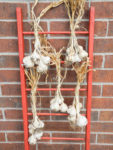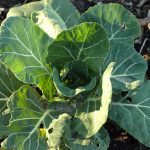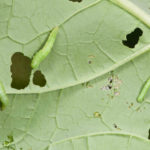Fall Finally Arrives in the October Vegetable Garden
I am so thankful for fall weather. Shorter days and cool mornings have brought back the gardening enthusiasm that the relentless heat of summer usually drains. That small stretch of rain we had last month really helped too. If you haven’t already, take advantage of the mild, frost-free weather this month and get cole crops, root crops, greens, and garlic established in the garden.
Try Garlic This Year
Garlic makes a great addition to any garden as long as you pick the right variety for the time of year you plan to harvest. I plant very early varieties to make sure that I get a good harvest in mid May. Usually May is our rainiest month, and in my heavy clay soil, the garlic heads will rot if I don’t get them out of the ground. For the rest of you with better soil, you’ll want to plant cloves this month and harvest no later than June.

Early maturing garlic varieties can be easy to grow.
Some online garlic sources are starting to sell out, but your local nursery may still have seed garlic in stock. You can plant them in a row, a raised bed, or even in your landscape. Prepare a planting area in full sun and add 3-4” layer of well-decomposed compost to help improve soil structure. Garlic likes to grow in fertile free-draining conditions. Plant the cloves 1-2 inches deep, 6” apart, with the pointy side up. Water regularly throughout the winter and fertilize every 2-3 weeks with fish emulsion, blood meal, or other high nitrogen fertilizer. Full sun and high fertility are needed to produce large bulbs. Cultivate lightly to eliminate competition from weeds being careful to not damage garlic’s shallow roots.
Two Categories of Garlic
There are two categories of garlic: hardneck and softneck. Hardneck is the type that forms a flower stalk or scape as it matures. It grows best in colder climates but you might have some success growing it in Central Texas, especially if you refrigerate it a few weeks before planting. Hardneck varieties include Purple Stripe, Music, Ajo Rojo and Metichi.
I’ve had much better luck with softneck garlic because it’s better suited to our mild winters. Varieties to look for include California Early, Lorz, Inchelium Red, Creole Red, Cuban Purple, and Texas Rose. My favorite variety is Chinese Pink, but I’ve only found it on the Burpee website this year.
There are hundreds of garlic varieties and every year I experiment with at least one new variety. When you find one that works for you, make sure to write down the name for next year.
October Vegetable Garden Checklist
If garlic isn’t your thing, here are some other items in your October vegetable garden checklist:
Fertilizer
- Fertilize garden vegetables with a water-soluble fertilizer or fish emulsion every 2 weeks as needed. You want to give plants every opportunity to grow before our first freeze hits in late November or early December.
Water and Irrigation
- Water as needed. Monitor the moisture in your planting beds by using a hand trowel. Dig down to a six-inch depth and use your hand to feel for a soil dampness. Many gardeners make the mistake of watering their mulch instead of getting irrigation directly into the soil.
- Newly planted seeds and transplants will need extra water to get established. Water more frequently until seeds and transplants put out new leaves.
Planting

- Plant garlic any time from mid-October thru early December.
- Start planting lettuce and spinach as the temperatures begin to cool; a little shade above the plants will help with establishment if warm weather lingers. Look for nursery transplants or plant seed directly in the garden.
- Cool-season herbs planted now, including cilantro, dill, chives, fennel, parsley and sage, will add zest to meals throughout the winter. Plan to let them flower in the spring to attract beneficial insects.
- Plant cover crops in fallow areas to improve the condition of the soil. Cool-season options include Elbon rye, clover, Austrian winter peas and hairy vetch. Elbon rye is also a good rotation crop if you have nematode issues. It forms thick root mats that nematodes invade but can’t reproduce in, thus reducing the population in the planting area. Elbon rye is also called “cereal rye” and most independent nurseries in Austin sell it. Make sure you are buying the rye grain, not ryegrass.
Diseases and/or Pests to Look For

Inspect plants regularly for caterpillars that can severely damage leaves of cole crops. Row cover or netting can be used to protect plants from moths that lay the eggs.
- Keep an eye out for fall pests such as caterpillars, aphids and harlequin bugs. Look for and destroy eggs. Handpick caterpillars. Use a strong spray of water to dislodge aphids from plants.
- Use row cover over brassica crops to keep the moths and butterflies from laying eggs on the foliage.
- As we get more rain, slugs and snails will start showing up again. Visit the garden at dusk to pick off these voracious pests. I take a small flat rock with me and have squish fests.
Maintenance
- Weeds love fall weather as much as vegetables. Keep them in check by regular pulling, hoeing and mulching. An extra bonus is that many weeds can be chopped up and added as a green to the compost pile.
- One of my favorite weeding tools for fall is a circle hoe. They are great for knocking back weed seedlings in vegetable beds as well as pathways.
- Watch the weather forecasts. The Austin area has had a freeze as early as Halloween. Get your frost protection ready so that it’s easy to put into place should we start to get cold temperatures. For me that means pulling my frost blankets out of an overhead rack.
Harvest
- Sweet potatoes are generally harvested this month as their growth begins to slow down. Cut back on irrigation 2-3 weeks before you plan to harvest so soil is dry. Dig carefully to avoid bruising, brush the dirt off and place in a dry, shady location to cure for 5-10 days before storing or eating. Keep pests like squirrels and rats from helping themselves by covering the drying rack with chicken wire and/or netting.
- Harvest winter squash and pumpkins when the rind is hard. Use pruners to cut from the vine, leaving 1-2 inches of stem attached. Be careful not to nick or scratch the skin as this could invite decay should you decide to store them.
Additional Resources
Watch the Vegetable Gardening in Central Texas Webinar
Recommended Vegetable Varieties for Travis County
Plant Rotations, Successions and Intercropping
Sustainable Food Center Farmers Markets
Monthly Gardening Calendar for Austin and Central Texas
About Sheryl Williams
 Sheryl Williams has been a Travis County Master Gardener since 2010 and currently works as the Horticulture Program Assistant at Texas A&M AgriLife Extension – Travis County. She was introduced to gardening by her mom and grandma and has been an avid vegetable gardener most of her life. Sheryl believes that there is nothing more satisfying than growing and preparing your own food. She likes gardening in Austin year round and concedes that means pulling weeds every day. She practices organic gardening principles and enjoys the challenge of outsmarting garden pests. Occasionally she loses these battles, but doesn’t mind sharing a good meal.
Sheryl Williams has been a Travis County Master Gardener since 2010 and currently works as the Horticulture Program Assistant at Texas A&M AgriLife Extension – Travis County. She was introduced to gardening by her mom and grandma and has been an avid vegetable gardener most of her life. Sheryl believes that there is nothing more satisfying than growing and preparing your own food. She likes gardening in Austin year round and concedes that means pulling weeds every day. She practices organic gardening principles and enjoys the challenge of outsmarting garden pests. Occasionally she loses these battles, but doesn’t mind sharing a good meal.
